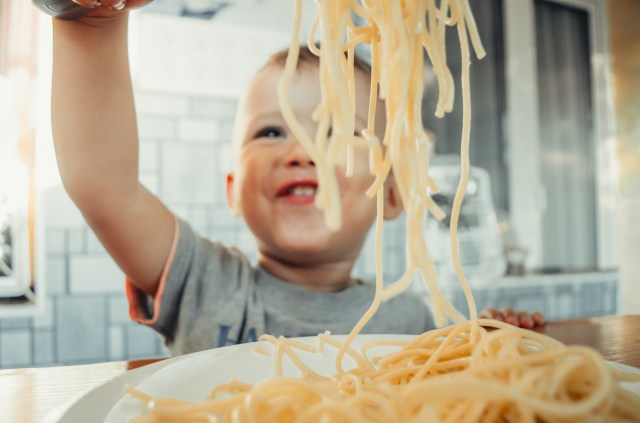Society’s obsession with protein has skyrocketed, and it’s all over our grocery store shelves—from protein-fortified cereals, chips, and crackers to protein waters. For parents, protein is definitely top of mind as you try to get even a morsel into your buttered noodle-obsessed kid’s body. But are we stressing a little more than we need to be? When it comes to protein for kids, how much do they really need?
Simply put, children need protein but they don’t need a lot of it. I know, sounds hard to believe, but don’t spit out your (microwaved) coffee in shock just yet. If your kid’s protein intake is consuming your thoughts, here’s what you need to know.
What makes protein so important anyway?
Protein offers kids sustained energy and satiety, which is helpful for both stay-at-home crawlers and active school-goers. It also slows carbohydrate digestion, preventing the blood sugar spikes that can make kids moody and tired. Protein is a powerful resource for children and an important part of a balanced diet.
How much protein do kids actually need?
Less than you think! Protein is essential for growth but their small bodies don’t need a ton of it just yet. Toddlers between the ages of 1 and 3 require 13 grams of protein per day and older kids between the ages of 4 and 8 only need 19 grams per day.
To put this in perspective, a single-serving container of Greek yogurt boasts 16 grams of protein—that’s more than a toddler’s daily requirement. Similarly, a peanut butter sandwich contains about 8-12 grams of protein, covering most of a child’s daily needs. So it’s safe to say that serving protein-rich foods once or twice a day should be sufficient. And if your child isn’t a big eater, don’t sweat it.
Tips and tricks for meeting your kid’s daily protein needs.
1. Beige foods for the win.

Even if your toddler refuses burgers at a BBQ or chicken fingers at grandma’s house, they can still get all the protein they need by eating beige foods—you know, the foods that toddler dreams and diets are made of. Think pasta, bread, and crackers. For example, you’ll find 7 g of protein in 3/4 cup of rigatoni. So when you feel guilty about serving pasta the third night this week, just remember that your kid’s protein needs for that day are half met. Mom win!
2. Explore out-of-the-box proteins.
Instead of loading your grocery cart with pricey protein bars and powders, you probably already have protein-rich food in your pantry. Did you know that carbohydrates are high in protein? Yup, that’s right. The next time your toddler grabs a second (or third) dinner roll, he’s likely eating protein too! Here are some other protein-filled carbs you may want to add to your pantry:
- 1/3 cup of rolled oats contains 6 g of protein
- 2 tbsp of hummus has 2 g of protein
- 2 slices of whole wheat bread includes 8 g of protein
- A couple handfuls of Cheerios contain 2-3 g of protein
- 4 tbsp of black beans has 3 g of protein
3. A little protein goes a long way.
While you can knock out your protein requirements with a couple of servings a day, picky eaters may require a little more ingenuity. Instead of serving large portions of protein at breakfast, lunch, and dinner, offer small amounts at meals and snacks. Consider adding ‘protein toppings’ such as chia seeds, hemp seeds, ground nuts, or seeds that can be sprinkled on oatmeal or yogurt or added to cereals, smoothies, and baked goods. It is much easier (and less overwhelming!) to meet protein needs by adding little bits throughout the day.

Putting it into practice.
Making sure your kids get enough protein doesn’t have to be a struggle. Including fan-favorite pantry staples (Hello Cheerios! Hi bread!) throughout the day will make meeting their needs more manageable for even the pickiest eaters. Here are a few examples of how to hit the mark each day using typical proteins and beloved beige foods:
Toddlers 1 to 3 years (13 g total):
- 1/2 cup whole cow’s milk (4 g), 1 slice of bread (4 g), 1/2 hard-boiled egg (3 g), 4 crackers (2 g)
- 1 tbsp peanut butter (4 g), 1/3 c oatmeal (6 g), 1 oz pasta (3 g)
- 3 oz Greek yogurt (8 g), 1/2 pita bread (3 g), 1 whole grain freezer waffle (2 g)
Kids 4 to 8 years (19g total):
- 1 cheese stick (7 g), 1/2 c of chickpeas (6 g), 1/2 peanut butter sandwich (6 g)
- 2 scrambled eggs (12 g), 1 mini bagel (4 g), 1 slice of cheddar cheese (4 g)
- 3 chicken nuggets (6 g), 1 oz cashews (5 g), 3oz Greek yogurt (8 g)











